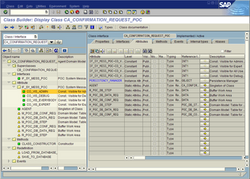| Release | Release date | Latest patch | End of life | Features |
|---|
| 1.0 | | | | First "GUI" for SAP software; no graphical elements like checkboxes, radiobuttons and icons |
|---|
| 1.1 | | | | Field length indicated by background colors; fast paths in menus |
|---|
| 2.0 | | | | New GUI for Windows 3.1; System and Application Toolbar added; icons in System Toolbar |
|---|
| 2.1 | | | | New graphical elements: checkboxes, radiobuttons, group boxes and push buttons on screen |
|---|
| 3.0 | | | | Table control introduced; icons added to buttons |
|---|
| 3.1 | 1996 | | | Windows95-look with flat buttons; tabstrip control and ABAP List Viewer (ALV) introduced |
|---|
| 4.0 | | | | Screens contain more information to reduce navigation |
|---|
| 4.5 | | | | Active X elements introduced; ALV is now based on grid control |
|---|
| 4.6D | July 2000 | | | GUI is re-designed; multiple-areas are introduced to reduce need for screen changes |
|---|
| 6.10 | July 2001 | | | |
|---|
| 6.20 | March 2002 | | December 31, 2010 | Scripting added [2] |
|---|
| 6.40 | June 2004 | | December 31, 2010 | Unicode support extended; accessibility and usability improved |
|---|
| 7.10 | February 2007 | | April 12, 2011 | Support for Microsoft Vista and Office 2007; new "Tweak SAP GUI" tool; new ABAP front-end editor |
|---|
| 7.20 | April 2010 | 17 (final) | April 09, 2013 [3] | Support for Windows XP; Windows 2003 Server; Windows Vista; Windows 2008 Server; Windows 7 and Office 2010; Built with Visual Studio 2008 [4] |
|---|
| 7.30 | June 2012 | 15 | July 15, 2015 | Usability enhancements; new customization features; built with Visual Studio 2010 |
|---|
| 7.40 | October 2014 | 19 | November 9, 2019 | Replaces Corbu with Blue Crystal; integrates SAP GUI for Windows 7.40 and Netweaver Business Client 5.0 |
|---|
| 7.50 | May 2017 | 15 (final) | April 9, 2019 | |
|---|
| 7.60 | February 2019 | 15 | April 12, 2022 | Introduces Belize theme, aligning GUI's visual design with the rest of SAP's Fiori applications. Retires Enjoy / Streamline / Tradeshow / SystemDependent themes. |
|---|
| 7.70 | January 29, 2021 | 16 | April 09, 2024 | |
|---|
| 8.00 | January 27, 2023 | 14 | January 12, 2027 | The 64bit version; Quartz themes: Modernization of rendering engine and some additional features; HTML Control based on Microsoft Edge: Improvements; Usability improvements in many components; Improvements for SAP Logon; Branding images per system and client |
|---|
|
